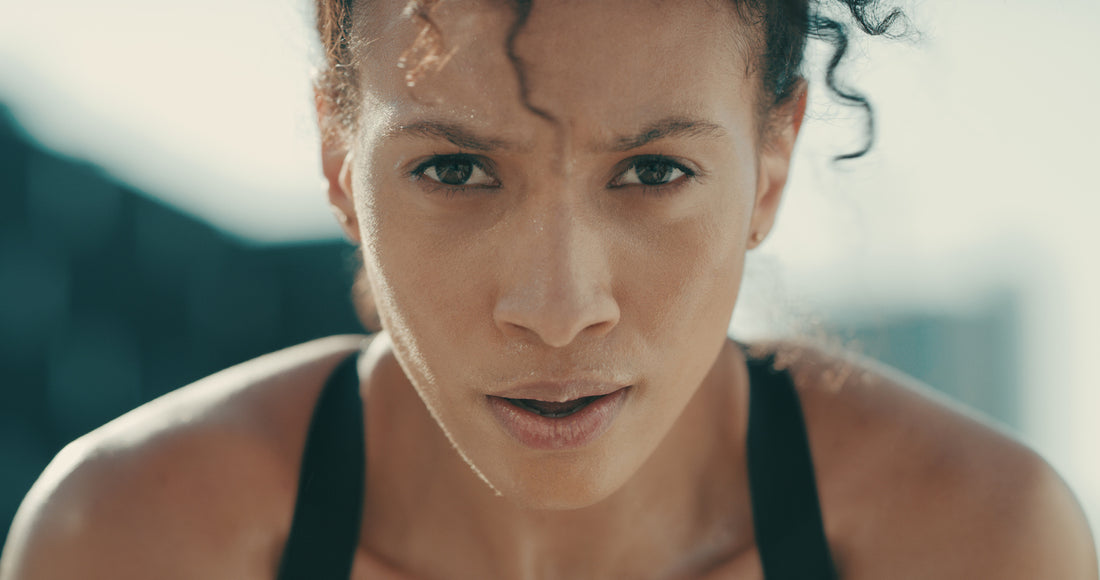
How to Stop Sweat from Damaging Your Hair

Sweat is one of those things that can really ruin your day in terms of hair care. Fortunately, there are ways to stop sweat from causing hair damage in curly hair or coily hair. This would include type 3 hair or type 4 hair, officially. Here is some info about what sweat does to hair, as well as some ways you can deal with sweat in your daily routine.
Why Is Sweat So Bad for Your Hair?
If you let sweat dry in your hair after your workout, it can damage your hair. The reason for this is because when sweat dries on your scalp, it leaves a residue that can clog your hair follicles with damaging bacteria. There's also the issue of the large amount of salt that's in sweat. This can cause the color of your hair to change.
It's well known that wet hair is more susceptible to damage, so leaving it damp and sweaty for that reason is not a great idea either.
Use Some Sweat Bands
Beyond looking stylish for activewear, something like a cotton headband can help tremendously in making sure that as little sweat gets into your hair as humanly possible. It's imperative to do this before a workout where you know that you're going to be sweating a lot, especially if you know that you do a lot of sweating from your head. Paying attention to these kinds of things can really help.
Plus, it's completely fine to wear a headband throughout the day if you know that you might be sweating for some other reason, like you have a long hike to work, or it will be hot in one of the areas that you'll be going to at some point throughout the day.
A good rule of thumb is that if you know you won't be able to help yourself out and rinse hair clean soon after sweating due to time or inconvenience, it's a good idea to prepare in advance with a headband or another method.
Do Whatever You Can to Prevent Sweat

Other options for preventing sweat from getting into your hair in the first place include trying dry shampoo, for example. This helps to suck up the moisture on your head and keep it from lingering on your scalp.
It's also a good idea to make sure you drink enough water during the day. Outside of being a good idea for general health anyway, it's also a good idea for maintaining your hair health and producing less sweat in the first place.
If you don't sweat much at all anyway, then it can't get in your hair. If you drink enough water, then you will sweat less because your body will be cooler. Also, if you can avoid doing anything else that will make you produce more sweat than you need, such as your clothing choices or where you decide to go during the day, this will help a lot as well.
Another solid habit to get into is brushing your hair after working out. This helps to distribute the oils evenly and makes it easier for your scalp to dry out properly.
Use Hairstyles and Preparation
Accessories and hairstyles can also be highly useful in keeping sweat from being too much of a problem in the first place. Here are a few different ways you can prevent the problem in the first place.
Wraps
Kind of like headbands, a hair wrap helps to absorb sweat. You will need it to make sure your hair doesn't flop into your face as you jump around anyway. Wraps tend to have a lot of different variety to them in terms of patterns, styles, and colors, so they are also great if you are looking for variety. You can wear them anyway, and then you will be ready for a workout at any time.
Having a Good Schedule
Don't be afraid to decide when to do workouts based on what tends to happen with your hair. For example, working out at night instead of the morning can be an effective way of making sure that sweat is less of a problem since you can attend to it properly and fight sweat more easily if you're doing it after work where you have time.
If you do your workout before work in the morning, you may not have as much time to treat it properly.
Just scheduling and planning it out ahead of time can go a long way to making sure you reduce any damage caused to your hair by sweating.
Hair Ties
Hair ties can help keep your hair out of the way of sweat gathering on your brow, but you need to make sure that you use the right kind of ties. For example, don't use hair ties with metal clasps because these can damage your hair all by themselves. You can get thick hair caught in the metal and cause breaks to your hair strands.
Plus, this can really hurt. If you get elastic ties like a scrunchie or just a standard small hair tie that's only cloth, then you can avoid this problem.
Side Braids
Wearing hair this way makes it easy to keep out of your face to reduce the possibility of sweating in the first place. Plus, it makes it less likely that it will become too much of a monotonous way to wear your hair in the first place. It also works just fine for going out as well.
Bun Hair Style
It doesn't take long to create a bun, which makes it ideal for exercising. You can try different buns so that one look doesn't get boring. You can go either low or high with them. It will keep the hair off your face, and it will help keep you fou from sweating as much due to your hair increasing it when it's down.
Frizziness can also be a problem with thicker hair, which is less likely to happen when you have a bun.
Always Use Conditioner After a Workout
In any workout where you could have damage due to having sweat in your hair afterward, it's a good idea to use a conditioner. You can either use the full-on conditioner or put it in a spray bottle and then rinse everything out. This should help to get anything damaging out of your hair.
The recommendation is to use a t-shirt to fully pull the water out of your hair after rinsing if you have hair that coils like in type 4. It's obviously better to try to avoid getting any sweat in there in the first place, but it's going to be hard to prevent anything from getting in there at all, and it's better to be safe than sorry. These things happen. When they do, you'll have to rinse to be sure since you may not be able to tell just by looking at it about how much sweat was absorbed.
It helps to use hair-dryers to make sure your hair dries safely after it's become wet for any reason. Some say that a hooded dryer is best since you can just wait there and then put a leave-in conditioner afterward. However, it's your hair, so you can try other approaches too, like using a hand-held dryer. If you add in a diffuser attachment, then you'll be all set to dry it out gently right after you work out and wash out your hair. Curly hair and coiled hair can soak up sweat, so it's crucial to make sure you wash it all out and dry it safely.
Drying with Reverse Air Dryers
One way to make sure your hair dries properly is by using the RevAir Reverse Air Dryer. This hair dryer is healthier than other options since it dries your hair without using chemicals or high heat. The dryer pulls in hair and keeps the heat directed at the hair instead of at your scalp. This way, your hair isn't damaged.
Summing Up
Since sweat is not good for your hair, it's important to do anything you can to reduce the possibility of this. One of the best options for reducing damage is just prevention. You can use any of your observations about when you sweat in the first place to do this less, for example.
You can also just wear things like sweatbands or hair wraps to soak up sweat or make sure your hair is out of your face with a hairstyle.
For more information about making sure that you keep from accidentally damaging your hair, regardless of how, as well as many other tips and options for helping out your look, please don't hesitate to contact us today. The faster you contact us, the faster we can make sure that you have everything you could need to get your hair exactly the way you want it and keep it that way over the long term with proper maintenance.
















